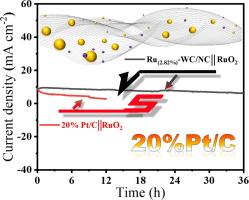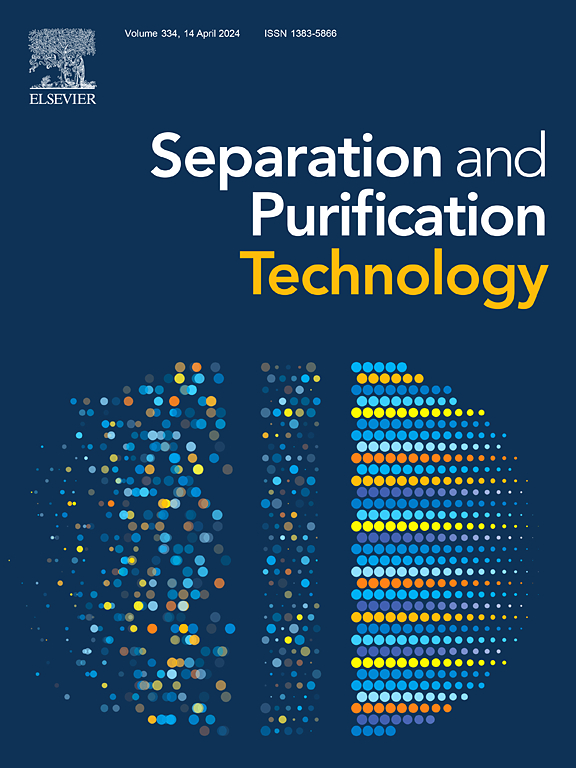Ru-WC/NC 0D-2D 纳米复合材料电催化氢气进化的高稳定性
IF 9
1区 工程技术
Q1 ENGINEERING, CHEMICAL
引用次数: 0
摘要
铂基贵金属催化剂是氢进化反应(HER)中重要而高效的电催化剂。然而,铂基贵金属催化剂在氢进化反应中稳定性差、成本高。本文通过气相还原热解工艺制备了独特的负载 Ru 的碳化钨/掺氮碳(Ru-WC/NC)0D-2D 纳米复合材料,以解决稳定性差和成本高的问题。具体来说,将 0D WC 支持的超小 Ru(2 nm)锚定在掺氮碳纳米片上。即使 Ru 的负载量仅为 2.82%,所开发的催化剂也能达到与 20% Pt/C 催化剂相当的高催化性能,并表现出卓越的稳定性。在 10 mA cm-2 的电流密度下,Ru(2)-WC/NC 催化剂在酸性条件下的过电位为 30 mV,在碱性环境下为 51 mV。此外,在超过 50 mA cm-2 的高电流密度下,Ru(2)-WC/NC 的过电位低于市售的 20% Pt/C。由 Ru(2)-WC/NC 和商用氧化钌组成的双电极系统在 10mA cm-2 电流下的分水总电位为 1.56 V。最重要的是,Ru(2)-WC/NC 的稳定性远远优于 Pt/C。理论计算结果进一步表明,Ru(2)-WC/NC 催化剂的 ΔGH* 可以通过 Ru 和 WC 之间的协同作用而降低,从而优化 HER 的动力学。本研究为合成和评估用低负载贵金属修饰的电催化剂提供了理论见解和实用方法。本文章由计算机程序翻译,如有差异,请以英文原文为准。


High stability of electrocatalytic hydrogen evolution from Ru-WC/NC 0D-2D nanocomposites
Pt based noble metal catalysts are important and efficient electrocatalysts during hydrogen evolution reaction (HER). However, the HER of Pt based noble metal catalysts have poor stability and high cost. Herein, Unique Ru loaded the tungsten carbide/nitrogen doped carbon (Ru-WC/NC) 0D-2D nanocomposites were fabricated by gas-phase reduction pyrolysis process to solve the problem of poor stability and high cost. Specifically, 0D WC-supported ultra-small Ru (∼2 nm) was anchored on nitrogen doped carbon nanosheets. Even with a remarkably low Ru loading of just 2.82 %, the developed catalyst achieves comparable high catalytic performance to that of a 20 % Pt/C catalyst and demonstrates superior stability. Under a current density of 10 mA cm−2, the Ru(2)-WC/NC catalyst shows an overpotential of 30 mV in acidic conditions and 51 mV in alkaline environments. Additionally, the overpotential of Ru(2)-WC/NC lower than that of commercially 20 % Pt/C at high current densities exceeding 50 mA cm−2. The total potential of water splitting for the two-electrode system comprising Ru(2)-WC/NC with commercial ruthenium oxide was 1.56 V at 10mA cm−2. Most importantly, the stability of Ru(2)-WC/NC is much better than that of Pt/C. Theoretical calculation results further revealed that the ΔGH* of Ru(2)-WC/NC catalyst could be reduced through synergistic interactions between Ru and WC, thereby optimizing the kinetics of HER. This study offers both theoretical insights and practical methodologies for the synthesis and evaluation of electrocatalysts modified with low loading of noble metals.
求助全文
通过发布文献求助,成功后即可免费获取论文全文。
去求助
来源期刊

Separation and Purification Technology
工程技术-工程:化工
CiteScore
14.00
自引率
12.80%
发文量
2347
审稿时长
43 days
期刊介绍:
Separation and Purification Technology is a premier journal committed to sharing innovative methods for separation and purification in chemical and environmental engineering, encompassing both homogeneous solutions and heterogeneous mixtures. Our scope includes the separation and/or purification of liquids, vapors, and gases, as well as carbon capture and separation techniques. However, it's important to note that methods solely intended for analytical purposes are not within the scope of the journal. Additionally, disciplines such as soil science, polymer science, and metallurgy fall outside the purview of Separation and Purification Technology. Join us in advancing the field of separation and purification methods for sustainable solutions in chemical and environmental engineering.
 求助内容:
求助内容: 应助结果提醒方式:
应助结果提醒方式:


